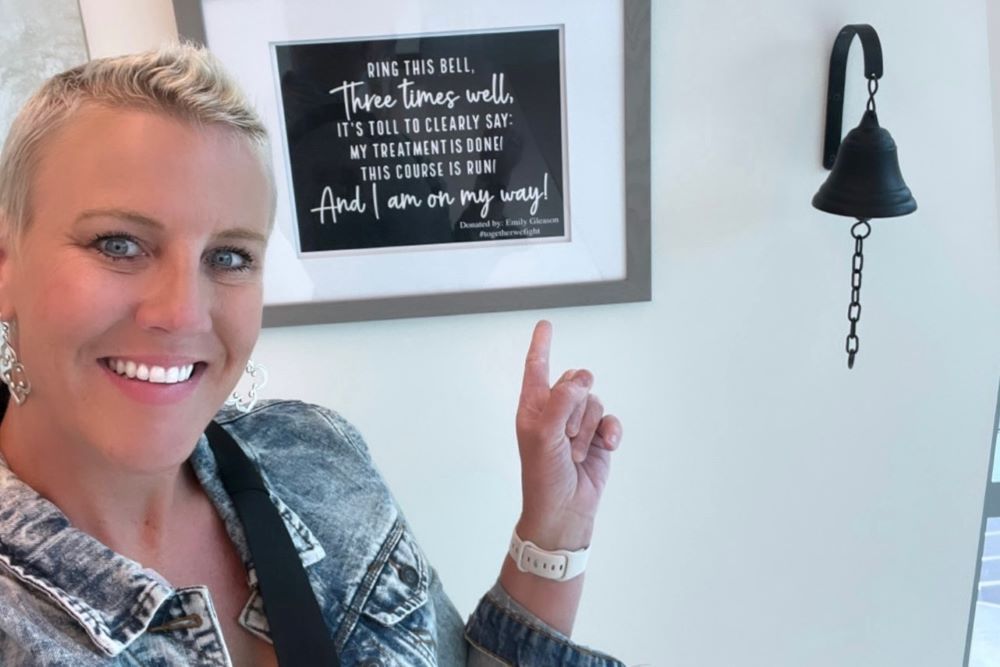Breast Health
Want to learn more about this at Kettering Health?
Emily Gleason chatted with her client, surrounded by the familiar noise of the hair salon. Then she got a MyChart notification. She knew what the notification was for. Her breast biopsy results.
She had a mammogram a couple of weeks earlier in September that came back clear. But after she felt a lump—the size and texture of a grape—in her left breast, her doctor ordered a biopsy.
Emily finished applying her client’s color and excused herself to the back to read the results. She didn’t understand what she read on MyChart so she called her husband, Cody.
“He told me, ‘Babe, I think that means you have breast cancer,’” she said. “And everything froze.”
Staying positive
Through tears, she called her doctor, who confirmed Cody’s suspicions: Emily had grade-three triple negative invasive ductal carcinoma, a very aggressive, fast-spreading form of breast cancer. An MRI and second biopsy showed that it was present in both breasts.
Emily’s world came crashing down. But she thought of her family—her four children: Brady, George, Kaylee, and Delaney—and knew she had to fight.
“The only outcome I could accept was survival.”
Emily’s breast surgeon, Dr. Roxane Weighall, and oncologist, Dr. Alejandro Calvo, decided to do chemotherapy before surgery due to the fast-spreading nature of her cancer. Chemotherapy would help prevent the cancer from spreading.
A few weeks after her diagnosis, Emily began chemotherapy on Nov. 14, 2022. Part of Emily’s treatment called for several rounds of doxorubicin, commonly called “the Red Devil” due to its red color and severe side effects. Despite exhaustion and nausea, Emily welcomed the treatment; she knew it was killing the cancer.
“I called it the Red Angel,” she shared. “Because it saved my life.”
Emily spent the winter traveling from an infusion chair at the Kettering Health Cancer Center to work to her children’s sporting events. It wasn’t easy, but her spirits were high.
Surrounded by love
Dr. Calvo told Emily, a hairstylist for 17 years, that her hair would most likely fall out during chemotherapy. This was something Emily dreaded.
“I’m a hairstylist. So hair is what I do,” she said. “I love my hair.”
She noticed it shedding more in the shower or when styling it. If this was all that was going to happen, it wasn’t so bad. Her hair was thinner, but she still had it.
In late February, Emily waited in line at a Chick-fil-A with her children. She ran her hand through her hair, and a clump fell out. She ran her hand through her hair again. Even more fell out. One of Emily’s biggest fears was coming true.
Later that day at the hair salon, Emily gathered the other stylists. It was time, she told them, to shave her head. After her last client, Emily sat in a salon chair. Her friends, coworkers, mom, older sister, and Cody surrounded her. Cody ran the hair clippers across Emily’s head, and the first bit of hair fell to the ground.
“I started to cry,” Emily said.
One by one, her loved ones took turns shaving Emily’s head until no hair was left.
A celebration
Emily had seen cancer survivors ringing bells online, and she wanted to take part in this tradition when her chemotherapy was over.
It had been months of treatment. Months of enduring chemicals in her body. Months of gathering the strength to go to her children’s sporting events. And Emily wanted a way to mark the end of this chapter.
“It’s something that was important to me,” she said.
She ordered a bell from Amazon and asked a friend who owns a printing shop to make a special sign explaining the bell. After her last chemotherapy session, on April 14, Emily gleefully rang the bell while her loved ones cheered.
Emily saw others going through the same thing as her. Other people waiting for their time in the infusion chairs to be over. She donated her bell and sign to the Cancer Center so others could ring it and celebrate the end of their journeys, too.
“I want other people to be able to celebrate that milestone,” she said.
Emily has since received several messages from friends and others telling her someone they know rang the bell. She even watched someone ring it herself during an immunotherapy session.
Looking ahead
A month after her last chemotherapy session, Emily had a double mastectomy on May 10. Going into the surgery, her care team wasn’t sure yet if the cancer had spread. If it was in her lymph nodes, it would be harder to treat.
Emily awoke from surgery, and Cody came in. “Did they tell you the news about your lymph nodes?” Cody asked. She shook her head, and he began to cry. “It’s not in there.” Emily cried, too.
Two days later, Emily and Cody talked with Dr. Weighall. There was no more cancer in Emily’s body. Emily fought hard, and she won.
“It was amazing to say that I’m cancer-free.”
The recurrence rate for triple-negative invasive ductal carcinoma is 20%. But with immunotherapy and chemotherapy pills, Emily’s recurrence rate drops to less than 10%.
She has several months before she’s done with her treatment. But when the time comes, and she leaves the infusion chair for the last time, she knows exactly what she’ll do.
“I want to ring the bell again. I’ll be done.”










